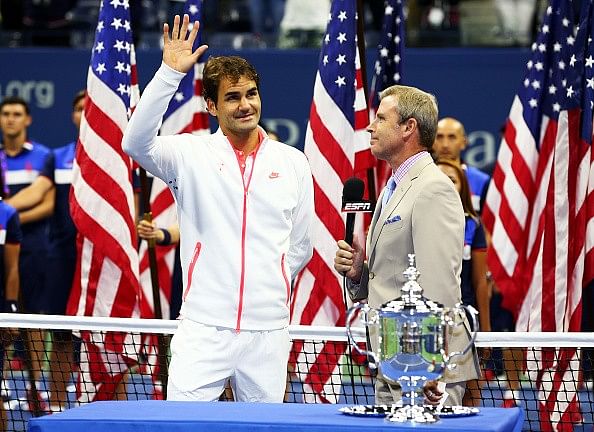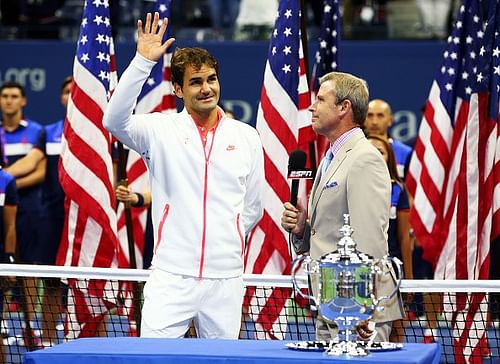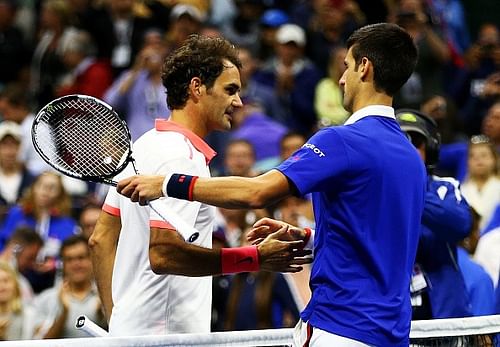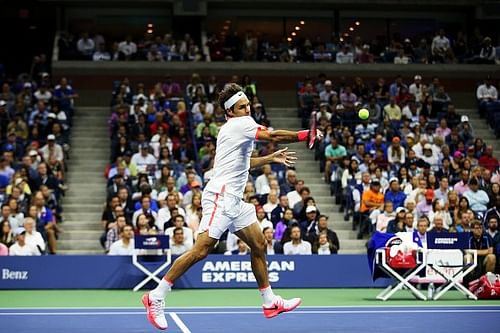
Why Roger Federer is bigger than the game of tennis

My work desk at home is often littered with random objects, and is usually a royal mess. But there’s one thing that has stood there unmoved since about three years: a framed picture collage of Roger Federer, Rafael Nadal, Novak Djokovic and Andy Murray, punctuated at the bottom with a quote attributed to Federer: “You can never be bigger than the game.”
Of course you can never be bigger than the game. Over the last half a decade the ‘Big 4’ have shown exactly that; they have taken turns to pull each other down (even if they have paradoxically elevated their status as a whole in the process), showing how precarious any player’s position is at the top. While Djokovic has pretty much sealed his hold over the men’s game for the foreseeable future, Nadal and Federer have continued to remain big threats, forever knocking on the door of dominance.
The picture was a gift by a friend who was well-acquainted with my fondness for tennis, and at the time I didn’t think much of it. But as three years have gone by, and as Federer has desperately tried, and repeatedly failed, to add to his Grand Slam record of 17 titles, I’ve kept coming back to the quote, and kept pondering the truth of it.
It hit home once again in a big way as Federer went down to Djokovic, yet again, in the US Open final. The loss was a fairly expected one; Djokovic had entered the match as the favourite, and he played like it. The Swiss may have had as many as 23 break points and converted as few as four of them, suggesting that this was a lost opportunity for him, but during the match you never really got the feeling that the match was his to lose. Djokovic always looked in control, while Federer always seemed on edge.
What caught everyone’s attention, however, was the greater-than-usual outpouring of support that Federer received from all quarters, most notably from the New York crowd. Admittedly, a pro-Federer crowd is nothing new; he’s enjoyed close to a decade of devoted fandom wherever he plays. So much so, that we actually entertained the possibility of the French crowd rooting against their own countrymen in last year’s Davis Cup final between France and Switzerland.
But the intensity and magnitude of it all still came as a surprise this weekend – all those years of spectators being wowed by Federer’s bag of tricks seemed to have reached a crescendo in New York. It seemed Djokovic had to fight not one, but two opponents – both of whom were pretty darned fiesty. The crowd cheered the Serb’s errors, roared at his double faults, even catcalled before his serve on the important points. And when he hit one of his blazing winners or made one of his unfathomable gets, they let out a hushed silence, almost daring him to do it again.
Such behaviour is not uncommon, but it clearly goes against all norms of social etiquette. A crowd that cheers when a player commits an error is not a crowd that respects sport. It’s rude, uncouth and plain uncool to do that, and a classic example of bullying.
So you’d think that if you pointed this out to a Federer fan, you’d get a defensive response like, “But they DID cheer some of Djokovic’s winnings shots!” or “They weren’t THAT loud,” or even a blunt, “It didn’t affect Djokovic anyway; he still won!”. But no; the only response that I saw from Federer fans was along the lines of, “Well, what did you expect? He was playing FEDERER!”
That’s the extent to which the Federer legend has permeated – any apologies made on his behalf aren’t even apologies. You can’t expect a justification, an explanation or even a denial if he ever gets an unfair advantage over his opponents. You’re just supposed to treat it as gospel, and deal with it.
“No. 18!” has become a rallying cry among his legion of fans all over the world. Nothing else seems to matter, nothing else merits any kind of discussion. Djokovic’s phenomenal three-Slam year has almost been reduced to an afterthought; while history will look kindly at his achievement, the acclaim in the present is sorely missing. Scores of people lamented the fact that Federer failed to convert 19 out of 23 break points, but very few applauded how Djokovic played his best tennis in the biggest moments, refusing to yield whenever his opponent threatened to strike.

Federer is not getting any younger, as you must have heard, so every time he steps on the court, he creates a huge buzz all over. Is this the last time we’ll get to see him play tennis? Will he never wield his magical racquet after this? Who will give us our our fill of on-court majesty when he leaves? How will we go on with our drab, wonder-less lives when he hangs up his boots?
When Federer said “I’ll see you guys next year” at the trophy presentation, the crowd let out the loudest roar of the evening. That was the moment everyone had been dreading; after Flavia Pennetta’s retirement announcment the previous day, there was no telling what crazy idea would enter Federer’s head, especially after suffering yet another gut-wrenching loss to his biggest present rival.
Except that we shouldn’t have been worried. Federer has been playing some of the best tennis of his career, he is clearly enjoying the sport to the fullest, and he has plenty of motivation to keep going on. Why should he retire? But that’s what his fans do; they turn everything into something bigger when it comes to Federer; a win becomes the second coming of Christ, a loss the apocalyptic harbinger of untold misery.
All through this rollercoaster ride, the man himself has done everything in his power to keep adding to the cacophony, if unintentionally. He’s worked hard on his game, refusing to let the younger generation pass him by. His resurgence the last two years has helped him establish a bit of a stranglehold on the No. 2 position, which at the age of 34 is an impressive feat whichever way you look at it.
He’s done other things too. He’s changed his racquet, brought on a new coach, invented a new shot, fathered a second set of twins, and in general lived the life of a carefree superhero who doesn’t just turn time, but also looks fabulous while doing it. His SABR (that’s ‘Sneak Attack By Roger, for the uninitiated) has been the talk of the sporting world, and I feel duty-bound to add here that any suggestion the shot might be a tad unsportsmanlike has been brushed aside as an unholy fabrication that has no place in the civilised world.
But Federer remains human, heart-breakingly so. His last three Slam final defeats have all been huge bubble-bursters, bringing him and his fans back to earth with a numbing suddenness. He didn’t drop a set before the final in New York, dropped just one set at this year’s Wimbledon, and last year he actually went into the final at SW19 as the favourite. Each time, he rode a wave of emotion and support all the way to the last hurdle, and it looked like he could do no wrong.
Djokovic disagreed, of course, and thrice in a row he’s put paid to the “No. 18! “ rallying cry with his unique mix of elastic defense and unshakeable resilience. For six matches Federer has looked unplayable, until he’s been outplayed by the Serb. For six matches he’s looked unbreakable, until he’s been broken by the World No. 1 – both literally and figuratively.
And yet Federer keeps coming back. The scores may not suggest it, but New York was actually an improvement over his two previous losses, and perhaps even closer than the 2014 Wimbledon classic. In that match he barely had any chances to break the Djokovic serve, and only extended it to five sets because of a rare lapse of concentration from the Serb.
But at the US Open, mid-way through the third set, the match could have gone either way; the missed break points at 4-3 may have been the biggest game-changer of the day. In New York, Federer had chances – 23 of them. Sure, Djokovic was as steady as ever throughout, but manufacturing chances and failing to take advantage of them is a lot better than not creating chances at all.

One day, Djokovic will crack – like Nadal did at the French Open in 2009. And that day, Federer will be right there, ready to take advantage, ripe for a conoration one last time. What does that make him – a shameless opportunist, or a vigilant soldier who doesn’t know what quitting means?
The answer to that question is not the most striking thing about this whole discussion; the most striking thing is that the answer is not relevant at all. Whether an opportunist or a fighter, Federer has elevated his persona to such an extent that nobody is willing to look beyond his tennis, his records, his place in history. It doesn’t matter whether he wins against a worthy opponent or takes advantage of a depleted field; it’s only important that he wins, period.
That’s not entirely surprising, considering how many epic losses he’s taken through his career. Federer has been called the Greatest Of All Time as well as the Greatest Loser Of All Time; he’s lost 10 Major finals now, and about half of those have been all-time classics. And yet he keeps coming back; he knows that he hasn’t always made the best use of his ridiculous gifts, but he’s willing to put himself on the line over and over again.
That, right there, could well be the biggest reason for his ever-increasing popularity. Why wouldn’t you want to cheer for the spectacularly talented star who’s been denied his ‘fair’ share of the spoils, and who wants nothing other than one more opportunity? It’s the classic case of ‘lost child’ syndrome; mothers want to comfort and hug him, fathers want to thump his shoulder in encouragement, and youngsters, well, they just want to trip on his delightful array of shots.
And the rest? They admire his incredible work ethic and discipline that are often concealed by his genius, and appreciate the fact that he makes nearly every match so entertaining and competitive – age, opponent or conditions be damned. They applaud his undying love for the game, and extol the way he respects his opponents. They celebrate his style, and love the way he has raised – and continues to raise – the collective level of men’s tennis, bringing us spectacular tennis from both ends of the court that we could have never hoped to witness without him.
The ‘Greatest Of All Time’ or ‘GOAT’ title is a funny concept; it changes hands almost as easily as we change our outfits. Two years ago I, like many others, was leaning towards Nadal for that honour. And heck, two years from now, we may all be jumping on the Djokovic bandwagon – 10 is not that far away from 17.
But at the moment, I’m back in Federer’s corner. His longevity is tough to argue against, and his aesthetic game has always been a plus point (even if it shouldn’t necessarily be so). More importantly, while the last two years may have been fruitless for him Slam-wise, they’ve showcased a side of him that I didn’t think he had.
The side that doesn’t know what it means to give up. The side that soldiers on, constantly in search of just one more victory. The side that makes the sport of tennis beautiful and brutal at the same time. The side that makes crowds remorselessly root against his opponents, and makes the entire sporting world focus more on his loss than the other man’s victory. The side that makes tennis junkies brag about him to non-tennis fans and challenge them to find a player like him in any other sport.
In short, the side that makes Roger Federer bigger than the game.